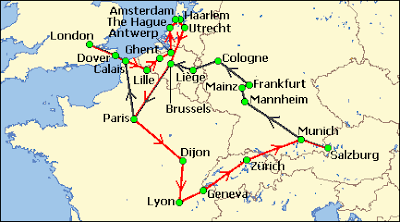Literature / Writers Datebook: January 29
A brief biography of the life and works of Anton Chekhov, Russian short story writer and playwright, one of Russia's great authors, a writer for ordinary people.
Anton Chekhov (1860-1904) was a 19th century Russian author, short story writer and playwright. He was one of the most popular and great Russian writers. Known as a 'moral compass', his plays and short stories are known for their realistic examination of the lives of ordinary Russians at the end of the 19th century. His most famous plays include: Uncle Vanya, The Seagull, Three Sisters and The Cherry Orchard. Some of his well-known short stories are: Ward No. 6, The Black Monk, The Student, and Ariadne.
Early Life
Chekhov was born on January 29, 1860 in Taganrog, a small port in southern Russia. When he was 15, son of an unsuccessful shopkeeper, his father went bankrupt, and the family left for Moscow to avoid paying debts. Chekhov stayed behind to finish school but was deeply affected by the separation.
Career as a Writer
When he was 19, Chekhov joined his family in Moscow. He studied medicine at Moscow University. While studying medicine, he also began writing stories, and by the time he became a doctor, he had published hundreds of them. His first book, Motley Stories, was successful enough to inspire him further to pursue writing as a profession. At 28, he began to be taken seriously as a writer, and he was awarded a literary prize. Four years later he became the physician for a poor area outside Moscow. While there he wrote some of his best short stories. From the proceeds of his writing he was able to purchase a modest home in the area and worked hard to improve conditions fro the people living there.
Later Years
Chekhov suffered from tuberculosis for some time, and by his late 30s he had to move to the warmer climate at Yalta in the Crimea, in southern Russia. There he wrote his most famous plays: Uncle Vanya, The Seagull, The Three Sisters and The Cherry Orchard. He was elected fellow of the Moscow Academy of Science, but resigned when his fellow-member, Maxim Gorky, was dismissed by the tsar's order.
In all his work Chekhov created dramatic tension through mood and setting rather than action or dramatic events. His works were never openly political, but they have been seen as critical of life under the Russian monarchy, or the tzars.
Legacy
Chekhov died aged 44. He was a writer for the masses, and his primary concern was for the people and their hopes and dreams.
Works by Anton Chekhov
Melpomene 1884
Motley Stories 1886
The Bear 1888
Ivanov 1888
The Wood Demon 1889
Sakhalin Island 1893-94
The Seagull 1896
Uncle Vanya 1897
The Three Sisters 1901
The Cherry Orchard 1903
Photo Credit:
Anton Chekhov. NNDB.com / Public Domain
Resources:
Cambridge Guide to Literature in English by Ian Ousby (1993)
Larousse Dictionary of Writers, edited by Rosemary Goring (1994)
Anton Chekhov. en.wikipedia.org
(c) January 2009. Tel. Inspired Pen Web. All rights reserved.



.jpg)


